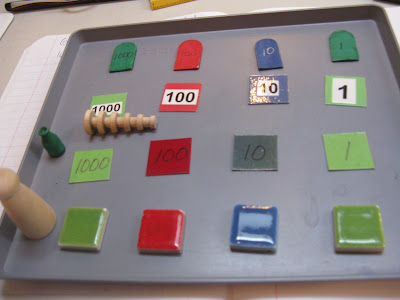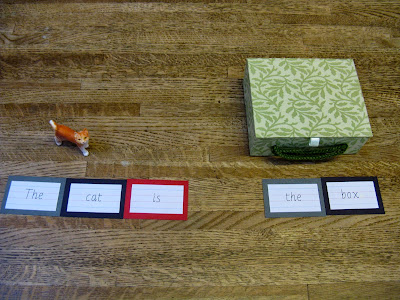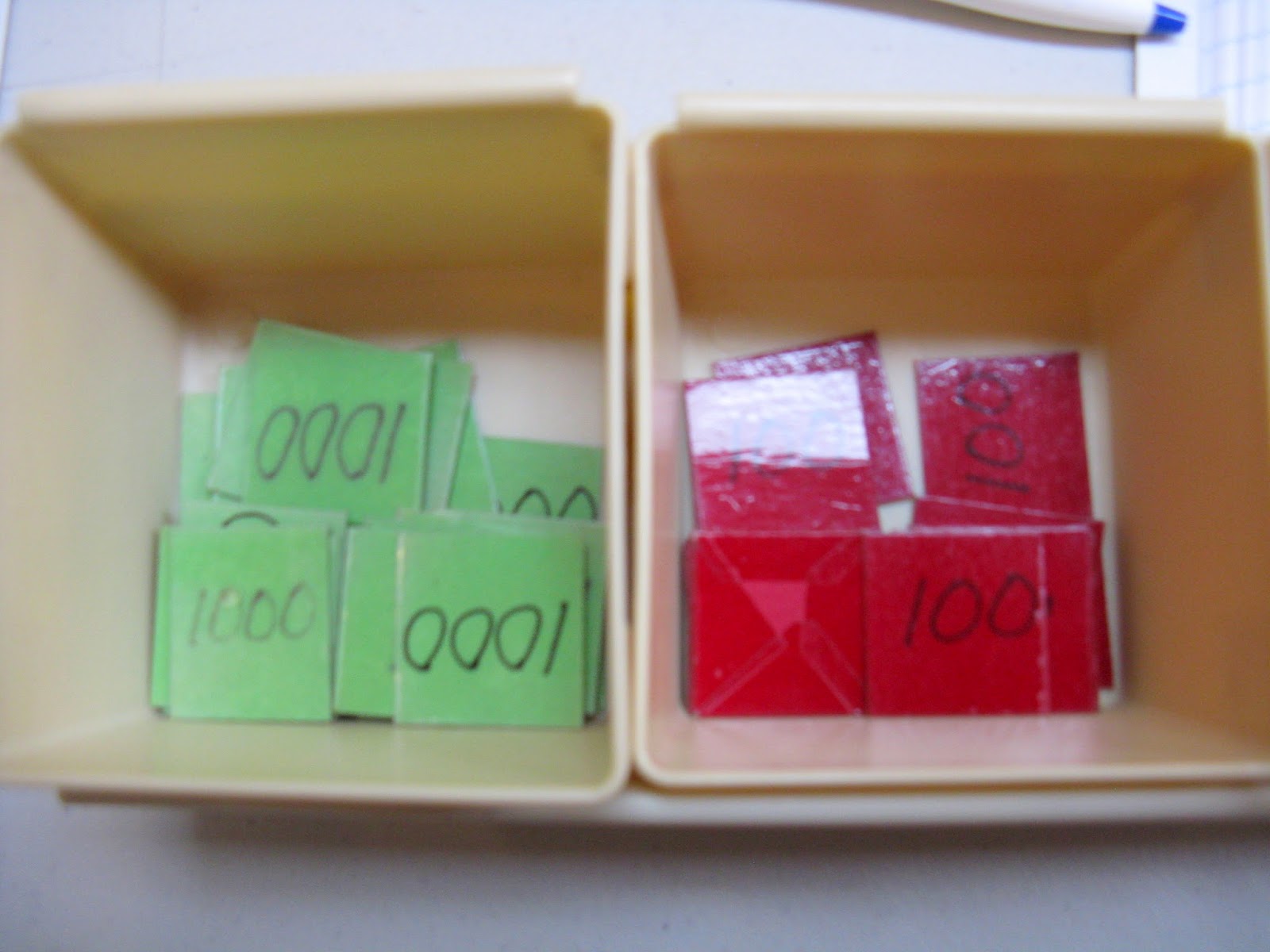Montessori Study
Wednesday, April 27, 2016
Tuesday, October 20, 2015
Tray of Nines
This is the Tray of Nines.
(Beads from 1 through 1000)
Spread the mat in front of the child.
(Beads from 1 through 1000)
 |
| Place value mat. |
Spread the mat in front of the child.
Explain that the letters on the top represent:
Units
Tens
Hundreds
Thousands
Units
"If we had one more unit...we would have ten."
Tens
Do the same with tens.
"One Ten, Two Tens, Three Tens..."
"If we had one more ten...we would have one hundred."
Exchange each time you move to the next place value. You can use an exchange tray.
Hundreds
Start counting out hundreds in the hundreds column.
As hundreds are counted, stack them on top of each other as if building a thousand-bead.
"If we had one more hundred....we would have one thousand."
Thousands
Exchange for the thousand.
*Note: don't refer to the shape of the beads (bar, square, cube,) as this might confuse the child later.
Math (ECE) Fall, pg 49
Units
Place the units one by one in the units column and have the child help count. "One Unit, Two Units, Three Units, etc..."
Place them vertically until you reach nine. Do the same with tens.
"One Ten, Two Tens, Three Tens..."
"If we had one more ten...we would have one hundred."
 |
| Counting Tens |
Exchange each time you move to the next place value. You can use an exchange tray.
Hundreds
Start counting out hundreds in the hundreds column.
As hundreds are counted, stack them on top of each other as if building a thousand-bead.
"If we had one more hundred....we would have one thousand."
Thousands
Exchange for the thousand.
*Note: don't refer to the shape of the beads (bar, square, cube,) as this might confuse the child later.
Math (ECE) Fall, pg 49
Wednesday, May 13, 2015
Tuesday, April 28, 2015
Division Board
The Division Board is similar to the Multiplication Peg Board, but it only goes to 9 on the top.
The top number is the divisor -the skittles at the top represent children with trays (as in division group games.)
Pegs, counted into the lid first and divided on the board, will be the dividend.
The quotient is on the left.
The problem below is 12÷ 6=2. (If twelve pegs are divided among 6 children, they will each get two.)
The top number is the divisor -the skittles at the top represent children with trays (as in division group games.)
Pegs, counted into the lid first and divided on the board, will be the dividend.
The quotient is on the left.
The problem below is 12÷ 6=2. (If twelve pegs are divided among 6 children, they will each get two.)
 |
| Versions of the Division Board |
Introducing the Division Board
Once
again, you have to make the connection to the Golden Beads.
Use
green
pegs
for thousands and units. Use red
pegs
for hundreds. Use blue
pegs
for tens.
Introduction to pegs and their values:
Say
"this is one unit" and "this green peg has the same
value as this unit."
"This blue peg has the same
value as this ten."
Tell child the peg containers are like
the "bank."
Friday, April 24, 2015
Tuesday, April 21, 2015
History of the Stamp Game
The Stamp Game corresponds directly to the Golden Bead material, but is more abstract.
Dr. Maria
Montessori originally
created the
stamp game using postage
stamps. She would
often create materials based on what the children were interested in.
Collecting stamps was popular at the time.
Below
are some of the various ways of making homemade stamps for the stamp
game.
Another
idea is to use foam.
The
Thousands
and Units should
be green, the Hundreds
are red, and the Tens
are blue.
A
set should contain...
For
static operations: 9 of each
For
dynamic operations: 30 of each
 |
| Commercial Material |
 |
| Different styles/possibilities for the stamp game. |
Subscribe to:
Comments (Atom)



















